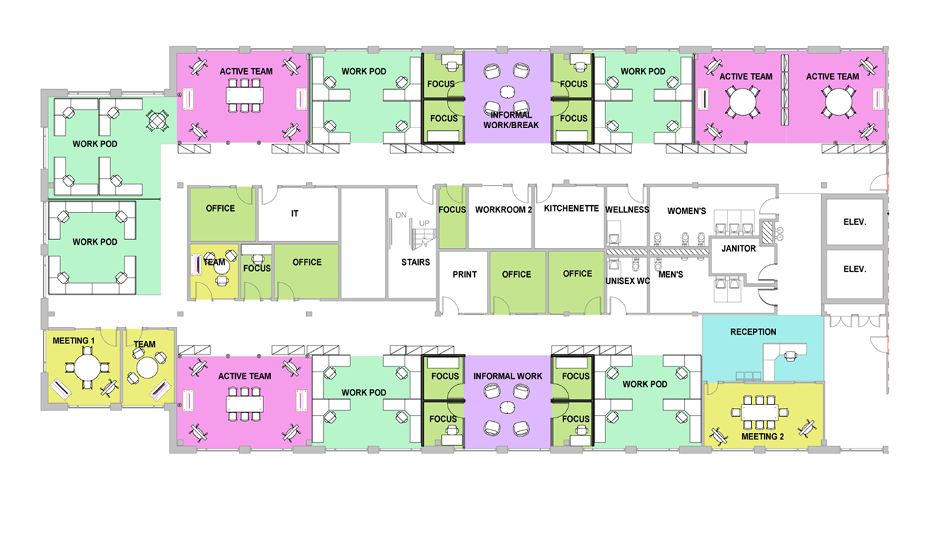News
Space Planning and the Post-pandemic Workplace
May 14, 2021The past year’s forced experiment in remote work has revealed that working from home is not so bad after all.
It turns out a lot of workers—and their employers—have discovered that working remotely often beats working from the office for many routine tasks.
As a result, many Vermont employers plan to combine in-person and at-home work once the threat of coronavirus fades. This hybrid model of work, often referred to as the agile workplace, has profound implications for office design in the years ahead.
The agile workplace: What is it?
Agile workplaces are spaces designed for maximum flexibility. Employees are not bound to conventional 9-5 work schedules, and they are free to work how, when and where they choose.
This approach requires a rethinking of office space that focuses less on the person and more on the task to be performed. For example,
- Many private offices and most workstations are shared, though some teams may be assigned to designated “pods”
- Private focus rooms allow for quick logins, individual focus work, or zoom meetings
- Open, flexible meeting areas encourage team project work, aided by technology
- Soft seating areas promote informal meetings or taking breaks
- Closed conference rooms of various sizes allow for meetings that require privacy
- Moveable workstations permit teams to easily reconfigure spaces as needs change
Sometimes agile workplace designs require less square footage than more traditional layouts, which means reduced costs for rent, utilities, and maintenance. Less space and less commuting also lowers the environmental impact of your business.
Often, however, companies keep the same square footage and use it in different ways. With an increased focus on collaboration, more amenity spaces such as lounges and conference rooms may be required. Likewise, permanent workstations may be removed or reassigned in favor of “hotel” stations that are not tied to any one employee. Keeping existing furniture and assigning it a different use is easier on the pocketbook and the environment.

Agile Workplace Example
Shown below is a typical floorplate for a small- to medium-sized office before and after the conversion to an agile workplace model. This example strives to re-use existing furniture and walls where possible and supplement with demountable partitions for flexibility as needs change. Ancillary spaces are unchanged. It assumes forty percent of staff will be in the office full-time, with the remainder working from home to various degrees.
Traditional Workplace: 69 FTE in office daily. 64 open office workstations; 4 private offices, 1 reception desk, 2 private focus rooms, 4 formal meeting rooms

Agile Workplace: 69 FTE total, 29 FTE in office daily, 40 in office part time. 24 open office workstations, 4 private offices (may be shared), 1 reception, 8 private focus rooms, 4 formal meeting rooms, 5 active team rooms, 8 lounge chairs for informal work or breaks

Is it worth it?
People who work in agile workplaces feel empowered, valued, and trusted with the freedom to manage their own time and find the way they work best. The result is often higher levels of employee satisfaction and productivity.
Agile workplaces also invite freer communication, collaboration, and creativity, which can help cultivate a strong company culture built on teamwork.
Agile workplaces encourage movement throughout the day, a major wellness benefit.
How do I get there?
Converting your business to an agile workplace requires a company-wide change in mindset that won’t happen overnight. But this moment in time offers a unique opportunity for change that we are unlikely to see again:
- After a year of working from home, employees are more open to change than ever before
- Employers have real-world experience with remote working and are ready to lead the charge
- Demand for commercial real estate is low, making more properties available at attractive rates
If you are interested in learning more about what it takes to convert your office to an agile workplace, contact Jane Pickell, Director of Interiors, to learn more.
Back
FIERO Design Award is Extra Special for UVM Rescue Alum Alex Halpern
Alex Halpern presents UVM Rescue’s Alicia Rosato with the FIERO Award for EMS Station Design Excellence...
